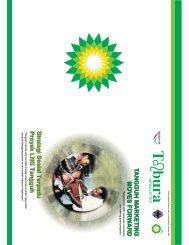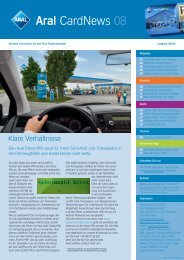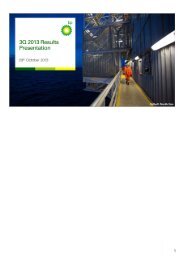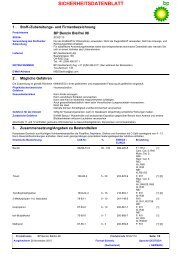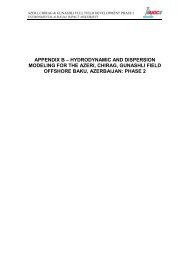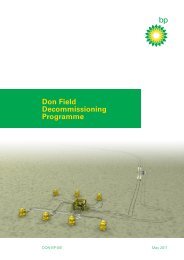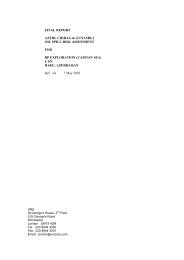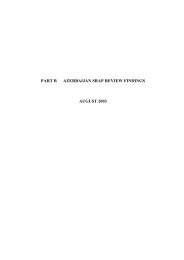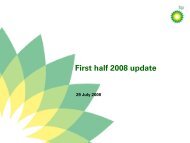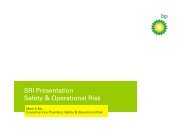You also want an ePaper? Increase the reach of your titles
YUMPU automatically turns print PDFs into web optimized ePapers that Google loves.
<strong>of</strong> <strong>the</strong> streamers. The<br />
three vessels <strong>the</strong>n travel for a<br />
set distance collecting data. After<br />
returning to <strong>the</strong>ir starting point, <strong>the</strong> source<br />
vessels are <strong>of</strong>fset from <strong>the</strong> receiver vessel<br />
and repeat <strong>the</strong> journey. This process takes<br />
place several times, collecting data from<br />
many azimuths – creating <strong>the</strong> width – to<br />
generate a much clearer image.<br />
<strong>BP</strong> has developed ano<strong>the</strong>r technique –<br />
Ocean Bottom Seismic Nodes – to help<br />
understand reservoirs lying under deep<br />
water. A series <strong>of</strong> nodes – pressure vessels<br />
containing recording equipment to detect<br />
vibrations on <strong>the</strong> seafloor – is placed on <strong>the</strong><br />
seabed, allowing <strong>the</strong> source vessel at <strong>the</strong><br />
surface to travel freely, shooting energy<br />
into <strong>the</strong> nodes from any direction on <strong>the</strong><br />
compass. The hardware was adapted from<br />
instruments more commonly used to<br />
record earthquakes, and is currently being<br />
used to make field management decisions<br />
Source vessel A<br />
at <strong>the</strong> Atlantis field, in <strong>the</strong> Gulf <strong>of</strong> Mexico.<br />
<strong>BP</strong> believes advanced seismic imaging<br />
has <strong>the</strong> potential to contribute to <strong>the</strong><br />
delivery <strong>of</strong> more than 1 billion barrels <strong>of</strong><br />
reserves, along with enabling access to<br />
more acreage, reduced exploration risk,<br />
lower costs and improved recovery.<br />
Indeed, advanced seismic imaging on<br />
narrow azimuth data has contributed to<br />
significant discoveries in Azerbaijan, while<br />
multi-azimuth seismic has enabled<br />
appraisal <strong>of</strong> reservoirs in Egypt, and wideazimuth<br />
seismic methods are supporting<br />
<strong>the</strong> appraisal and development <strong>of</strong> <strong>BP</strong>’s<br />
deepwater assets in <strong>the</strong> Gulf <strong>of</strong> Mexico. ■<br />
WATS uses a standard 3D seismic vessel with<br />
receivers incorporated into towed streamers to<br />
collect <strong>the</strong> data, but ra<strong>the</strong>r than using a sound<br />
source mounted on <strong>the</strong> recording boat, additional<br />
source boats are deployed. This ‘wide azimuth’<br />
approach yields enhanced detail <strong>of</strong> <strong>the</strong> subsurface<br />
geology obscured by salt deposits.<br />
Recording vessel<br />
Seismic stats<br />
➔80%<br />
The amount <strong>of</strong> future exploration and<br />
production expected to lie under salt in<br />
<strong>the</strong> Gulf <strong>of</strong> Mexico<br />
➔60%<br />
The amount <strong>of</strong> <strong>the</strong> <strong>BP</strong>-operated Block 31<br />
in Angola that is covered by salt<br />
➔1 billion<br />
The number <strong>of</strong> barrels <strong>of</strong> reserves to<br />
which <strong>BP</strong> believes advanced seismic<br />
imaging has <strong>the</strong> potential to contribute.<br />
<strong>BP</strong> MAGAZINE Issue 1 2009 09



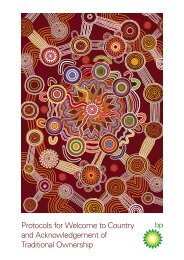
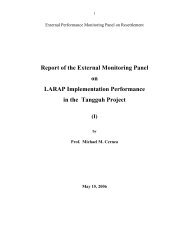
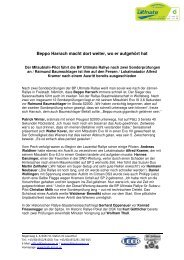
![[PDF] Deepwater Horizon: Accident Investigation Report - BP](https://img.yumpu.com/51697031/1/190x245/pdf-deepwater-horizon-accident-investigation-report-bp.jpg?quality=85)
